In vitro reconstitution of the cyanobacterial photoprotective mechanism mediated by the Orange Carotenoid Protein in Synechocystis PCC 6803
- PMID: 21764991
- PMCID: PMC3226224
- DOI: 10.1105/tpc.111.086884
In vitro reconstitution of the cyanobacterial photoprotective mechanism mediated by the Orange Carotenoid Protein in Synechocystis PCC 6803
Abstract
In conditions of fluctuating light, cyanobacteria thermally dissipate excess absorbed energy at the level of the phycobilisome, the light-collecting antenna. The photoactive Orange Carotenoid Protein (OCP) and Fluorescence Recovery Protein (FRP) have essential roles in this mechanism. Absorption of blue-green light converts the stable orange (inactive) OCP form found in darkness into a metastable red (active) form. Using an in vitro reconstituted system, we studied the interactions between OCP, FRP, and phycobilisomes and demonstrated that they are the only elements required for the photoprotective mechanism. In the process, we developed protocols to overcome the effect of high phosphate concentrations, which are needed to maintain the integrity of phycobilisomes, on the photoactivation of the OCP, and on protein interactions. Our experiments demonstrated that, whereas the dark-orange OCP does not bind to phycobilisomes, the binding of only one red photoactivated OCP to the core of the phycobilisome is sufficient to quench all its fluorescence. This binding, which is light independent, stabilizes the red form of OCP. Addition of FRP accelerated fluorescence recovery in darkness by interacting with the red OCP and destabilizing its binding to the phycobilisome. The presence of phycobilisome rods renders the OCP binding stronger and allows the isolation of quenched OCP-phycobilisome complexes. Using the in vitro system we developed, it will now be possible to elucidate the quenching process and the chemical nature of the quencher.
Figures

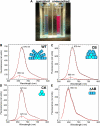
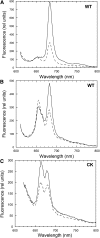

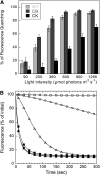
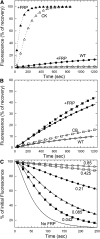
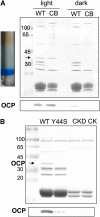

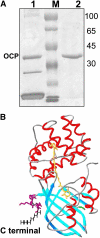
References
-
- Adir N. (2005). Elucidation of the molecular structures of components of the phycobilisome: Reconstructing a giant. Photosynth. Res. 85: 15–32 - PubMed
-
- Ajlani G., Vernotte C., Dimagno L., Haselkorn R. (1995). Phycobilisome core mutants of Synechocystis PCC 6803. Biochim. Biophys. Acta 1231: 189–196
-
- Bailey S., Grossman A. (2008). Photoprotection in cyanobacteria: Regulation of light harvesting. Photochem. Photobiol. 84: 1410–1420 - PubMed
MeSH terms
Substances
LinkOut - more resources
Full Text Sources
Other Literature Sources
Molecular Biology Databases
Miscellaneous

